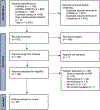Facilitators and Barriers to Pediatric Nurse Practitioner Practice in the United States: A Systematic Review
- PMID: 38284964
- PMCID: PMC11222060
- DOI: 10.1016/j.pedhc.2023.12.003
Facilitators and Barriers to Pediatric Nurse Practitioner Practice in the United States: A Systematic Review
Abstract
Introduction: The pediatric nurse practitioner (PNP) workforce was designed to improve child health equity. We aimed to systematically review the evidence on facilitators and barriers to PNP practice.
Method: We included empirical studies on PNP practice in the United States and excluded studies with non-identifiable PNP data. We applied Joanna Briggs Institute tools to appraise studies and applied critical interpretive synthesis principles to synthesize.
Results: The final sample is 26 studies, mostly published before 2013 and observational. Prescriptive privileges, training program availability, organizational climate, and telehealth are facilitators. Mandated physician supervision, reduced pediatric curricula, geographically disparate training programs, and poor data infrastructure are barriers. The sample is limited by a moderate to high risk of bias.
Discussion: Evidence suggests modifiable factors impact PNP practice and could have important implications for child health equity. We offer a theoretical model to guide robust research studying the PNP workforce and health equity.
Keywords: Workforce; health equity; health policy; pediatric nurse practitioners; systematic review.
Copyright © 2023 National Association of Pediatric Nurse Practitioners. Published by Elsevier Inc. All rights reserved.
Conflict of interest statement
CONFLICT OF INTEREST None to report. The authors wish to acknowledge John Usseglio, an informationist at Columbua University, for their assistance with developing the search strategy.
Figures
Similar articles
-
Health professionals' experience of teamwork education in acute hospital settings: a systematic review of qualitative literature.JBI Database System Rev Implement Rep. 2016 Apr;14(4):96-137. doi: 10.11124/JBISRIR-2016-1843. JBI Database System Rev Implement Rep. 2016. PMID: 27532314
-
Nurses as substitutes for doctors in primary care.Cochrane Database Syst Rev. 2018 Jul 16;7(7):CD001271. doi: 10.1002/14651858.CD001271.pub3. Cochrane Database Syst Rev. 2018. PMID: 30011347 Free PMC article.
-
Pediatric nurse practitioner workforce shortage threatens child health equity: Key contributors and recommendations.J Am Assoc Nurse Pract. 2023 Nov 1;35(11):661-665. doi: 10.1097/JXX.0000000000000954. J Am Assoc Nurse Pract. 2023. PMID: 37883490 Free PMC article.
-
Factors that impact on the use of mechanical ventilation weaning protocols in critically ill adults and children: a qualitative evidence-synthesis.Cochrane Database Syst Rev. 2016 Oct 4;10(10):CD011812. doi: 10.1002/14651858.CD011812.pub2. Cochrane Database Syst Rev. 2016. PMID: 27699783 Free PMC article.
-
Experiences of registered nurses as managers and leaders in residential aged care facilities: a systematic review.Int J Evid Based Healthc. 2011 Dec;9(4):388-402. doi: 10.1111/j.1744-1609.2011.00239.x. Int J Evid Based Healthc. 2011. PMID: 22093388
Cited by
-
Barriers and facilitators in nurse prescribing practices: a protocol for qualitative meta-synthesis from nurses' perspectives.BMJ Open. 2024 Dec 12;14(12):e084103. doi: 10.1136/bmjopen-2024-084103. BMJ Open. 2024. PMID: 39672575 Free PMC article.
-
Digital Training for Nurses and Midwives to Improve Treatment for Women with Postpartum Depression and Protect Neonates: A Dynamic Bibliometric Review Analysis.Healthcare (Basel). 2024 May 14;12(10):1015. doi: 10.3390/healthcare12101015. Healthcare (Basel). 2024. PMID: 38786425 Free PMC article. Review.
References
-
- American Association of Nurse Practitioners. (2022). State practice environment. https://www.aanp.org/advocacy/state/state-practice-environment.
-
- American Nurses Association. (2021). Nursing: Scope and standards of practice. American Nurses Association.
-
- Bargeman M, Abelson J, Mulvale G, Niec A, Theuer A, & Moll S. (2022). Understanding the conceptualization and operationalization of trauma-informed care within and across systems: A critical interpretive synthesis. Milbank Quarterly, 100 (3), 785–853. doi: 10.1111/1468-0009.12579 - DOI - PMC - PubMed
Publication types
MeSH terms
Grants and funding
LinkOut - more resources
Full Text Sources
Miscellaneous



